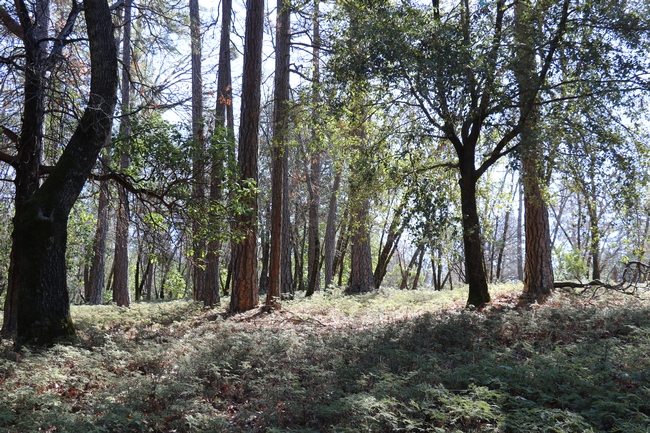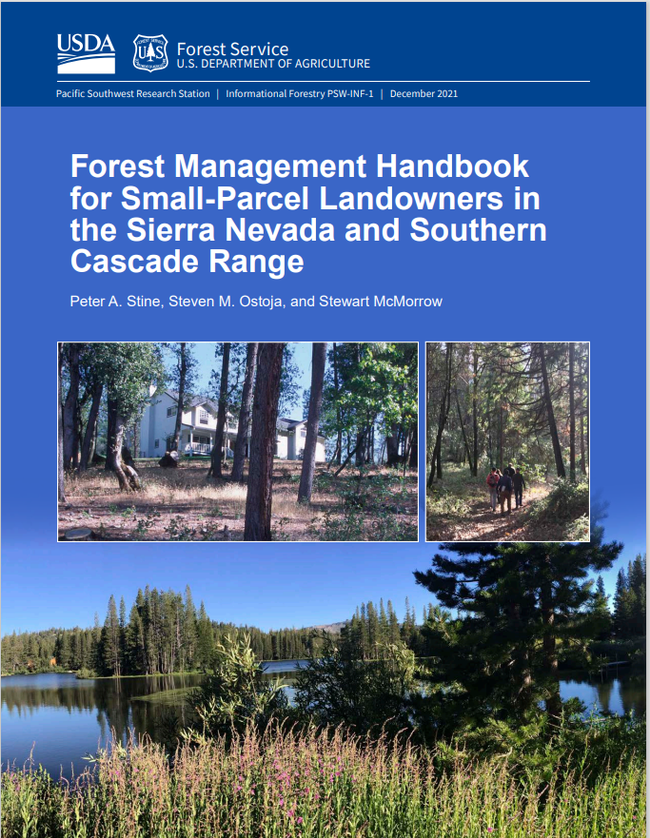Forests in the Sierra Nevada and southern Cascade Range are being stressed by many factors that put them at risk. High-severity wildfire, drought stress, insect outbreaks, disease, and a backdrop of changing climate are a few. A significant portion of Sierra Nevada and southern Cascade forests are owned and managed as small parcels (10 to 100 acres) by nonindustrial private landowners. To assist these landowners, CAL FIRE and the U.S. Forest Service Pacific Southwest Research Station have recently released the ‘Forest Management Handbook for Small Parcel Landowners.' This step by step guide is an additional resource designed to help small, private forest landowners gather the information needed to begin developing a California Cooperative Forest Management Plan, including determining what, if any, management actions need to be done, and where to obtain technical and financial support.
“California's small private landowners need access to tools and technical assistance to help them manage their forest lands to maintain forest health,” said Stewart McMorrow, CAL FIRE's wildfire resilience staff chief. “Forest landowners do not always have the knowledge or skills to get started with a management plan, which is why the handbook was created.”
Four important areas are addressed in the handbook including:
- Defining your forest management objectives;
- Assessing your current forest conditions;
- Recognizing threats to the health of your forest; and
- Evaluating possible treatment options.
A California Cooperative Forest Management Plan (CCFMP) can be simple or complex based on a landowner's management goals and objectives. For those ‘do-it-yourself' landowners, the handbook provides worksheets that can help guide you through basic management activities. For landowners with larger parcels, multiple goals, complex management activities, and a desire to participate in cost-share programs (i.e. CFIP or EQIP), a Registered Professional Forester (RPF) is required to complete and submit your management plan. However, the handbook can be used as an important first step to assist landowners and guide conversations with their RPFs.
The handbook can be found here and hard copies can be requested by contacting your local CAL FIRE Forestry Assistance Specialist.
Join handbook authors Stewart McMorrow, CAL FIRE (Stewart.mcmorrow@fire.ca.gov), Steve Ostoja, USDA California Climate Hub (smostoja@ucdavis.edu), and Peter Stine, Pacific Southwest Research Station (peter.stine@usda.gov) for a webinar on April 26, 5 p.m. – 6 p.m. to learn what the handbook offers and to get connected with programs and resources.
For landowners who would like more assistance in understanding and developing a California Cooperative Forest Management Plan, consider signing up for an upcoming Forest Stewardship Workshop series hosted by the University of California Agriculture and Natural Resources. The nine-week online workshop covers:
- Forest management objectives and planning
- Forest health, insects and disease
- Forest and fire ecology, wildlife, watersheds
- Fuels reduction and forest resource marketing
- Project development & permitting
- Getting professional help and cost-share opportunities
The in-person field day covers silviculture, forest inventory and mapping activities. Participants who complete the workshop will be eligible for a free site visit with a California Registered Professional Forester.

